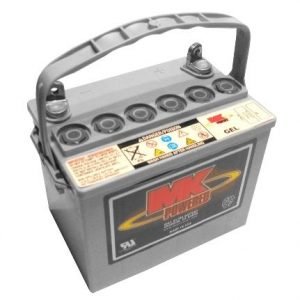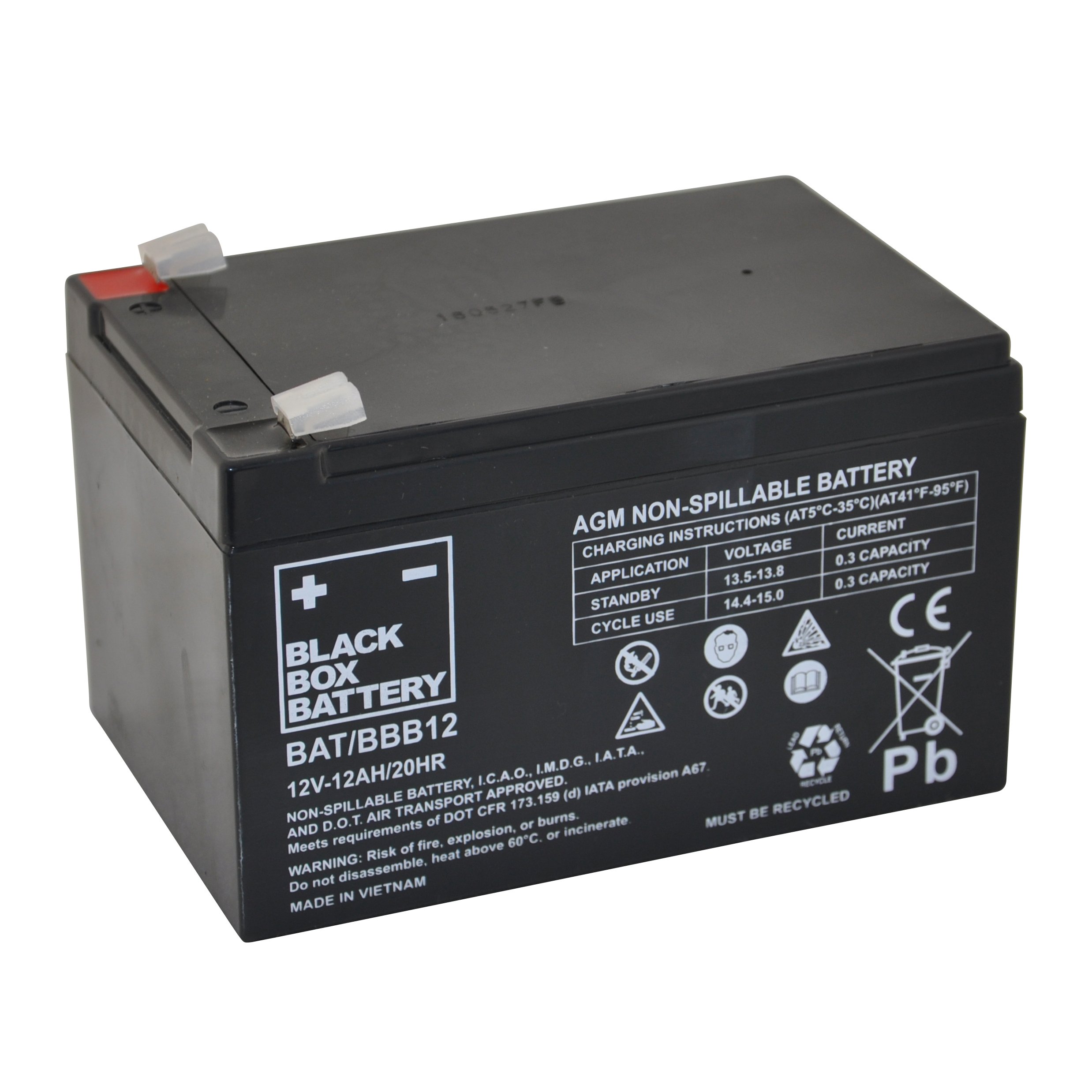Deciding which battery you want may seem complicated at first as not all mobility scooter batteries are the same. There are two different types: Sealed Lead Acid (SLA) batteries (also referred to as Absorbed Glass Mat (AGM) batteries) and GEL Mobility Batteries, AND they can come in different sizes. A few simple steps will enable you to select the correct one for your machine.
GEL batteries produce more cycles than SLA batteries and therefore last longer. Below is a summary of the two types:

Sealed Lead Acid |  GELMobility Scooter BatteriesPrices From:£47.99 Inclusive of VAT*.
Recommended for daily mobility scooter and powerchair users, GEL mobility batteries are the ultimate battery, offering unrivalled performance. These batteries are also suitable for electric golf buggies and golf trolleys. |
*Many battery retailers offer batteries for disabled customers VAT free. However, as much as we’d like to, this isn’t something that we are able to offer as HMRC advice states that companies are only able to supply batteries zero rated for VAT if that company both supplies and fits the batteries in that single transaction.
All scooter / electric wheelchair batteries are 12 volt and are usually fitted in pairs, which gives a 24 volt output. It is recommended that when batteries are replaced they are replaced in pairs.
The power output is marked in amp hours (Ah) on the side of the battery E.g. 12 volt 35A/h. The physical size of batteries with similar amp hour rates may vary between manufacturers, so it is crucial to choose a battery with the correct measurements for your scooter.
Once you have identified which battery Amp hour you require, the next thing you need to decide is whether you want a GEL battery or a Sealed Lead Acid (SLA) battery (also referred to as an Absorbed Glass Mat (AGM) battery).
Both batteries are sealed, non-spillable and maintenance free. The main difference between them is the performance/longevity. As the battery in a scooter or power chair is the only power source, it is designed to work differently to other batteries, for example, car batteries.
A car battery is designed to start a car and needs to produce a large amount of power as you turn the key, which is then replaced through trickle charging as the engine runs. A GEL or SLA battery is designed to give a constant flow of power over a longer period, and is then fully recharged – which is known as a cycle. GEL batteries produce more cycles than SLA batteries and therefore last longer.
Battery Installation

- Take a look at our YouTube video “How to change mobility scooter batteries”
- Wheelchairs and scooters typically require two batteries with 24-volt series connection. Never mix and match different battery manufacturers or technologies, or use batteries that do not have similar date codes. Never mix Gel batteries and AGM batteries.
- Always fully charge batteries prior to use
- Follow installation and start-up instructions provided by the mobility equipment manufacturer.
Break-In Period
Active users of power wheelchairs cycle their batteries daily (deep cycling). This stringent application requires a unique battery design that will sometimes compromise initial capacity in return for longer battery life.
Gel battery performance improves once the battery has been cycled (discharged and recharged) 20-25 times. This break-in period is necessary to fully activate the battery for maximum performance and longevity. Thus, range and running time of your mobility device could initially increase with use.
When to charge?
- Charge Daily
- The charger supplied with your mobility device should fully charge your batteries overnight. Overcharging is not a problem with today’s smart chargers as they are voltage limited and shut off automatically. Sealed Gel and AGM batteries do not exhibit a “use it or lose it” capacity-robbing effect known as “memory”.
- Mobility Pitstop stock a range of mobility scooter and powerchair battery chargers for all battery tyres.
Proper Charging Guidelines
- Use the equipment manufacturer’s automatic charger for all routine charging or a suitable equivalent.
- Never use an automotive or wet-type charge on Sealed Gel or AGM batteries as doing so will damage your battery.
- Depth of discharge affects cycle life. The harder a battery has to work the shorter its life expectancy.
- Avoid ultra-deep discharges and never drain your batteries completely.
- Do not leave your batteries in a low state of charge for an extended length of time. Charge a discharged battery as soon as possible.
- Do not cycle your batteries at a low state of charge without regularly recharging them fully.
Storage and Maintenance

- Always store your batteries FULLY CHARGED
- Check all stored batteries once a month and recharge as needed.
- Fully charged Sealed Gel and AGM batteries can hold a charge for up to 6 months, however, they should always be charged before use.
- When storing a power chair or scooter for more than 4 weeks, charge the batteries first and then disconnect them for storage.
- Avoid hot and cold extremes when storing.
- Sealed Gel and AGM batteries require no watering. Any performance-related issues should be handled by a properly trained wheelchair or scooter technician.
Safety
Batteries can be hazardous
- Dropping a tool or touching a watch or bracelet across the terminals can result in an electrical shock, sparks, smoke, fire and even and explosion. Use extreme caution around exposed battery terminals.
- Battery posts, terminals and related accessories contain lead and lead compounds, and other chemicals known to the state of California to cause cancer and birth defects or other reproductive harm. Wash hands after handling.
- BE CAREFUL! Batteries produce explosive gases. Keep sparks, flames and cigarettes away from batteries at all times. ALWAYS wear safety glasses and a face shield when working on or near batteries. Ventilate well. Do not install in an airtight container.
- All old batteries are consider “hazardous material” and must be recycled through an approved agency to prevent improper disposal. Lead-acid batteries are virtually 100% recyclable.
Sizing Chart
The chart below shows approximate sizes in both millimetres and inches for each battery size. Within the product description on mobilitypitstop.com you will find the dimensions of each battery.
| Millimetres | Inches | |||||
| Battery Ah | Length | Width | Height | Length | Width | Height |
| 1.3Ah | 97 | 43 | 59 | 3.82 | 1.69 | 2.28 |
| 2.2Ah | 178 | 34 | 66 | 7 | 1.38 | 2.5 |
| 2.9Ah | 79 | 56 | 106 | 3.06 | 2.19 | 4 |
| 3.4Ah | 134 | 67 | 66 | 5.25 | 2.63 | 2.44 |
| 5Ah | 90 | 70 | 108 | 3.54 | 2.76 | 4.21 |
| 8Ah | 151 | 65 | 100 | 5.94 | 2.56 | 3.94 |
| 10Ah | 151 | 65 | 114 | 5.94 | 2.56 | 4.61 |
| 12Ah | 151 | 99 | 100 | 5.94 | 3.88 | 3.88 |
| 15Ah | 151 | 99 | 100 | 5.94 | 3.88 | 3.88 |
| 18Ah | 181 | 76 | 167 | 7.13 | 3 | 6.5 |
| 22Ah | 181 | 76 | 167 | 7.13 | 3 | 6.5 |
| 27Ah | 166 | 175 | 125 | 6.5 | 6.87 | 4.94 |
| 35Ah | 195 | 131 | 181 | 7.68 | 5.16 | 7.13 |
| 40Ah | 196 | 165 | 165 | 8 | 6.5 | 6.5 |
| 50Ah | 196 | 165 | 165 | 8 | 6.5 | 6.5 |
| 55Ah | 229 | 138 | 232 | 9 | 5.43 | 9.13 |
| 60Ah | 259 | 169 | 178 | 10.25 | 6.625 | 7 |
| 75Ah | 260 | 168 | 232 | 10.25 | 6.61 | 9.13 |
Be the first to know about our special offers, subscribe to our newsletter >>

